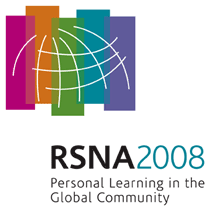
Abstract Archives of the RSNA, 2008
Justin Routhier, Presenter: Nothing to Disclose
Courtney A. Woodfield MD, Abstract Co-Author: Nothing to Disclose
Second-look ultrasound (US) with or without biopsy is a common recommendation in the work-up of suspicious lesions on breast MR. However, some MR visible lesions are sonographically occult. The purpose of this study is to determine if certain characteristics of suspicious lesions on MR predict US visibility to help determine which patients should go to second-look US for further evaluation and possible biopsy versus directly to MRI guided biopsy.
Following IRB approval, we retrospective reviewed the contrast enhanced breast MR exams of all patients at our institution from June 2006-October 2007 who had suspicious lesions on MR with subsequent targeted US of the area. Patient demographics, study indication, breast composition, lesion size, location, geometry, enhancement kinetics, and pathology (if biopsied) were recorded. The proportion of patients with sonographically visible lesions were compared across each MR characteristic using the chi-square statistic. Lesion visibility as a function of lesion size was also analyzed using a ROC curve
Sixty-four patients with 64 suspicious lesions on breast MR were included in this study with a mean age of 51.3 years (SD 8.7). Twenty-one (33%) of all patients underwent initial breast MR for screening (defined by BRCA mutation, family history, dense breasts, and/or personal history of breast cancer >6 months prior to MRI). Of the 64 patients who underwent second-look US, 27 (42%) had sonographically visible lesions. Lesion geometry defined as “mass” versus “non-mass, focus, or clumped” on MRI was a significant predictor of sonographic visibility (p = 0.03). Breast composition, lesion size, and enhancement kinetics were not significant predictors of US visibility. Twenty-five of the 64 patients (39%) had US-guided biopsy of the lesion of which 16(65%) were benign, 1(4%) was ADH, and 8(32%) were invasive carcinoma.
Breast MR lesions with “mass” geometry were more likely to be visualized on second-look US than “non-mass” lesions. Patients with suspicious “mass” lesions of all sizes on MR may benefit most from second-look US and US-guided biopsy as opposed to being referred directly to MR-guided biopsy.
Knowing which MR lesions are most likely to have an US correlate could help triage patients to second-look US versus directly to MR-guided biopsy.
Routhier, J,
Woodfield, C,
Predicting the Utility of Second-look Ultrasound for Suspicious Breast Lesions on MRI. Radiological Society of North America 2008 Scientific Assembly and Annual Meeting, February 18 - February 20, 2008 ,Chicago IL.
http://archive.rsna.org/2008/6012132.html

